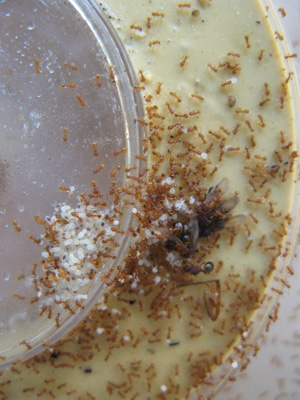Little Fire Ant

Little fire ant workers and queens
Photo: Dr. Arnold H. Hara, CTAHR
Problem
You get stung when you prune your trees, harvest bananas or dig in your garden. Sometimes, these pests drop down on you from above, getting into your clothing, stinging when agitated.
Description
Little fire ants are a relatively new pest to Hawaii and, unfortunately, appear to be here to stay. If you have come in contact with the Little Fire Ant, then you know that this is a pest to be taken very seriously! The bite of the Little Fire Ant burns like fire and some people can develop red welts that burn and itch for days. These pests can hitchhike onto your property in potted plants, mulch, firewood, and soil. They also migrate. If your neighbors have Little Fire Ants, then chances are you will encounter Little Fire Ants on your own property in time.
Unfortunately, once your property is infested with Little Fire Ants, you will probably never successfully eradicate them. The best you can do is to avoid bringing them onto your property in the first place and, if your property or home is infested, to manage their numbers by using the methods developed by Dr. Cas Vandervoude.
Fire! Little Fire Ants in Hawaii (2016)
Information
- Detect, Report, Stop! Little Fire Ant
- Hawaii Ant Lab for complete information on identification and control
- LFA Hawaii.org: http://lfa-hawaii.org/
- INVASION: Little Fire Ants in Hawaii (MISC) - YouTube video
- STOP the Little Fire Ant
- Identifying the Little Fire Ant (Kaua'i)
- Big Island Invasive Species Committee, 23 E Kawili St., Hilo HI 96720
SURVEY YOUR PROPERTY FOR LFA: Here’s an easy way to use chopsticks and peanut butter to test your property for the presence of Little Fire Ants. Not all ants that show up at the peanut butter buffet are Little Fire Ants. There are other protein eating ants that are little, and red, so take the time to identify them accurately.
IDENTIFY THE ANTS: Put ant specimens in a ziplock bag and freeze them, or put ants in rubbing alcohol. Take or mail your ant specimens for identification to one of the following:
- Big Island Invasive Species Committee, 23 E Kawili St., Hilo HI 96720
- Hawaii Ant Lab, 16 E Lanikaula St. Hilo, HI 96720
- Rob Curtiss, HDOA Entomologist: Leave samples at Kona CES Office, 79-7381 Hawaii Belt Road, Kealakekua, HI 96750-7911, Phone: (808) 322-4884
- Agricultural Diagnostic Service Center, 1910 East-West Road, Sherman Laboratory 134, Honolulu, Hawaii 96822, Phone: (808)956-6706, email: adsc@ctahr.hawaii.edu
TREAT FOR LITTLE FIRE ANTS:
- Once you have surveyed your property and confirmed that you have LFA, begin treatment.
- Treat with bait every 4-6 weeks, until no ants are found on surveys. Best times to treat are early morning or late afternoon. Do not treat in the rain.
- Apply barriers to keep ants from entering your home, if you are getting bitten inside. Do NOT apply barriers to the border of your lot if your property is currently infested. Creating a barrier on your border while your still treating will prevent the ants from taking the bait back to their nest if they are nesting on surrounding properties.
- Once ants are no longer present, survey your property at least 4 times a year to detect any new accidental infestations.
MANAGE LITTLE FIRE ANTS: Information on how to manage little fire ants on your property.
Little Fire ants in MULCH: Is it safe to use the mulch from a green waste site?
Kendal Lyon, Hawaii Island Master Gardeners

